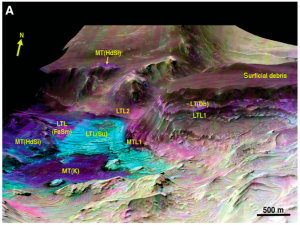Noctis Labyrinthus, created 2 to 3 billion years ago, is a sprawling network of intersecting valleys and troughs between the Tharsis volcanic highlands and Valles Marineris. Deep within its troughs, canyon walls and floors display beds of layered rocks and deposits of water-altered minerals.

COLORFUL CLAYS. Data from the CRISM spectrometer on the Mars Reconnaissance Orbiter, as converted into false colors, combined with topography and morphology derived from the HiRISE camera, maps numerous deposits of hydrated minerals deep in a trough where valleys intersect in Noctis Labyrinthus. The mineralogy suggests that the older deposits formed under acidic conditions, while later ones are chemically neutral - inverting the generally accepted scheme for Mars' chemical evolution. (Image taken from Figure 2a in the paper.)
Two small troughs within Noctis, however, contain a richer assortment of these water-related minerals than almost any place else on Mars. Writing in Geology (September 2), Catherine Weitz (Planetary Science Institute) and colleagues map and identify 11 individual geologic units in one of the locations, and 13 in the other.
The scientists report, “The diverse minerals in these two troughs indicate many events involving water and deposition that occured over a long time.” Geologic features within the deposits also indicate that the minerals were laid down while the Noctis canyon system was still growing.
Groundwater, hydrothermal activity, and melting snow/ice are all plausible sources for the water that created these minerals. “We found no channels or other fluvial features along the adjacent plateau,” the team notes, ruling out surface flows of water into either trough.
More intriguing is the global chemical evolution implied by the nature of the hydrated minerals. A widely held view among scientists is that early Mars was chemically neutral producing clays and then it evolved through volcanic activity toward a generally acidic environment that formed sulfates.
In a reversal, the team found the older layers in one trough formed under acidic conditions, while later deposits were neutral. In the other trough, the mineral deposits went from neutral to acidic and then back to neutral.
The team notes, “The observations indicate that the troughs underwent localized aqueous conditions that were inverted relative to the global chemistry of Mars.”
That has interesting implications for life, they explain. “These places were potentially habitable zones for life 2 to 2.5 billion years ago, when drier conditions dominated the surface.”









Pingback: Planet report | Selaiyur
Pingback: Secrets in the Labyrinth of Night | Riding with Robots on the High Frontier